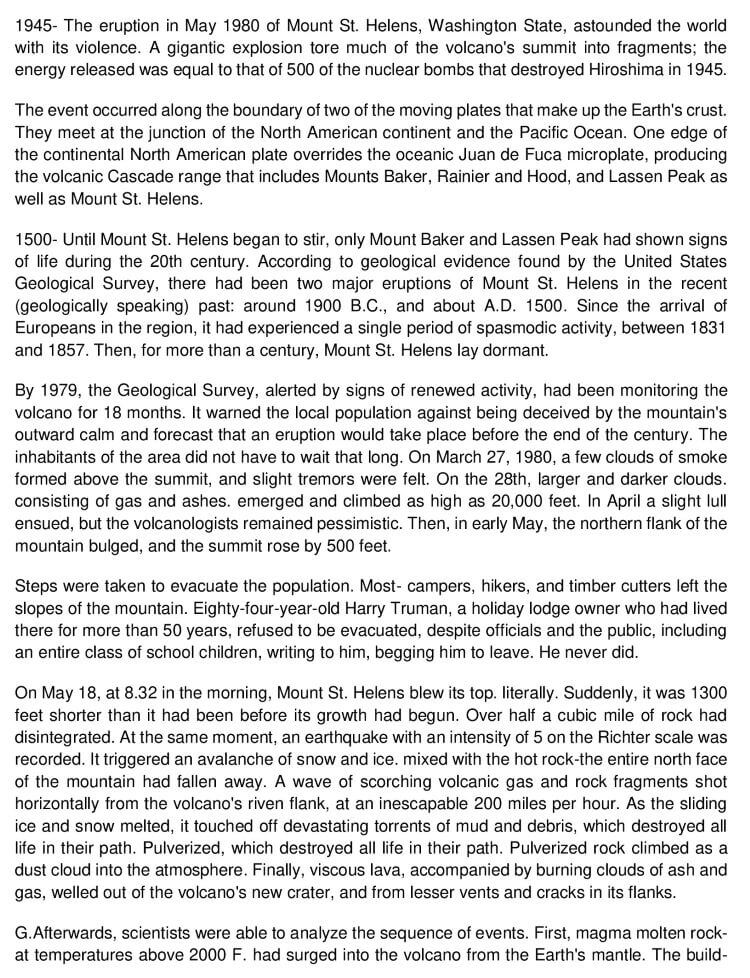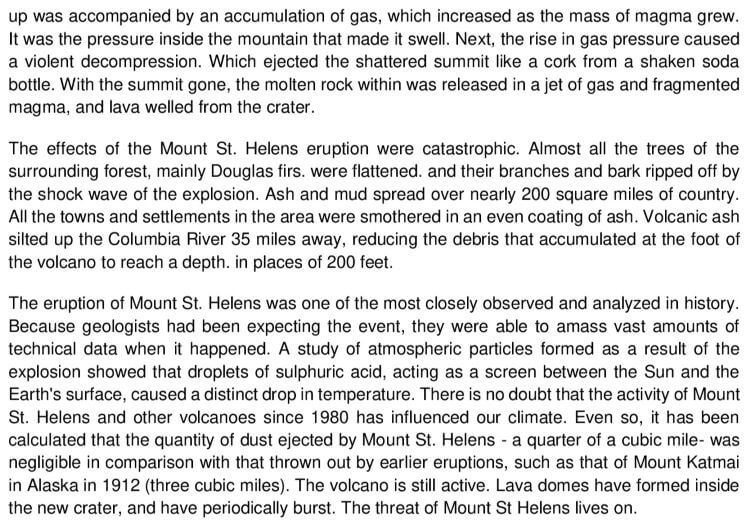The Spectacular Eruption of Mount St Helens – IELTS Reading Answers
6 min read
Updated On
-
Copy link
Table of Contents

Try AI Essay Checker for Instant Band Score
The IELTS Examination in Reading module has several passages with different type of questions. The reading passage, ‘The Spectacular Eruption Of Mount St Helens’, is a passage with several question types which you can attempt. You can attempt to find the answers of the passage, ‘The Spectacular Eruption Of Mount St Helens’, to find the difficulty level of the passages in the actual IELTS reading test.
If you want to practice on more passages to solve, try taking one of our IELTS reading practice tests.
Here are the question types in the reading test
Reading Passage (The Spectacular Eruption Of Mount St Helens)
- Short Answer Questions (Q.1 – Q.4)
- Summary completion (Q.5 – Q.8)
- Table Completion (Q.9 & Q.10)
- Multiple Choice Questions (Q.11)
You shouldn’t take more than 20 minutes to attempt this passage. You can check the answers with explanation for the passage, ‘The Spectacular Eruption Of Mount St Helens’, at the end.
Reading Passage
The Spectacular Eruption of Mount St Helens


Questions 1 and 2
Reading Passage 1 has 9 paragraphs labeled A-I
Answer questions 1 and 2 by writing the appropriate letter A-I in boxes 1 and 2 on your answer sheet
1 Which paragraph describes the evacuation of the mountain?
2 Which paragraph describes the moment of the explosion of Mount St. Helens?
Questions 3 and 4
3 What are the dates of the TWO major eruptions of Mount St. Helens before 1980? Write TWO dates in box 3 on your answer sheet.
4 How do scientists know that the volcano exploded around the two dates above?
Questions 5-8
Complete the summary of events below leading up to the eruption of Mount St. Helens. Choose NO MORE THAN THREE WORDS from the passage for each answer.
Write your answers in boxes 5-8 on your answer sheet.
In 1979 the Geological Survey warned … 5 … to expect a violent eruption before the end of the century. The forecast was soon proved accurate. At the end of March, there were tremors and clouds formed above the mountain. This was followed by a lull, but in early May the top of the mountain rose by … 6… . People were …7 … from around the mountain. Finally, on May 18th at …8 …, Mount St. Helens exploded.
Questions 9 and 10
Complete the table below giving evidence for the power of the Mount St. Helens eruption.
Write your answers in boxes 9 and 10 on your answer sheet.
| Item | Equivalent to | |
|---|---|---|
| Example
The energy released by the explosion of Mount St. Helens |
Answer
500 nuclear bombs |
|
| The area of land covered in mud or ash | …9… | |
| The quantity of dust ejected | …10… | |
Question 11
Choose the appropriate letter A-D and write it in box 11 on your answer sheet
- According to the text, the eruption of Mount St. Helens and other volcanoes has influenced our climate by …
- increasing the amount of rainfall.
- heating the atmosphere.
- cooling the air temperature.
- causing atmospheric storms.
Reading Answers
1 Answer: E
Question type: Matching information
Answer location: Paragraph E, Introductory line
Answer explanation: The paragraph starts with “ Steps were taken to evacuate the population.” This suggests that the evacuation steps were taken to protect the population.
2 Answer: F
Question type: Matching information
Answer location: Paragraph F, Introductory lines
Answer explanation: On May 18, at 8.32 in the morning, Mount St. Helens blew its top. literally. Suddenly, it was 1300 feet shorter than it had been before its growth had begun. This suggests the eruption of Mount Helen.
3 Answer: 1900 B.C., A.D. 1500.
Question type: Short-answer question
Answer location: Paragraph C, lines 1-4
Answer explanation: “Until Mount St. Helens began to stir, only Mount Baker and Lassen Peak had shown signs of life during the 20th century. According to geological evidence found by the United States Geological Survey, there had been two major eruptions of Mount St. Helens in the recent (geologically speaking) past: around 1900 B.C., and about A.D. 1500.” This suggests the major dates of notable eruptions of Mount Helen took place in 1900 B.C. and A.D 1500.
4 Answer: geological evidence/signs/data
Question type: Short-answer question
Answer location: Answer explanation: “According to geological evidence found by the United States Geological Survey, there had been two major eruptions of Mount St. Helens in the recent (geologically speaking) past: around 1900 B.C., and about A.D. 1500.” This suggests that the geological evidence found the dates of the eruption of Mount St. Helen. This is how scientists came to know about the eruptions.
5 Answer: (the) local pollution// inhabitants
Question type: Summary completion
Answer location: Paragraph D, lines 2-3
Answer explanation: “It warned the local population against being deceived by the mountain’s outward calm, and forecast that an eruption would take place before the end of the century.” This talks about the warning that was issued to the local population with regard to the eruption.
6 Answer: 500/five hundred feet/ft
Question type: Summary completion
Answer location: Paragraph D, last line
Answer explanation: “Then, in early May, the northern flank of the mountain bulged, and the summit rose by 500 feet.” This clearly states the height by which the summit (top of the mountain) has risen.
7 Answer: evacuated
Question type: Summary completion
Answer location: Paragraph E, Introductory line
Answer explanation: The paragraph starts with “ Steps were taken to evacuate the population.” This suggests that the evacuation steps were taken to protect the population.
8 Answer: 8:32 A.M. (in the morning)
Question type: Summary completion
Answer location: Paragraph F, Introductory lines
Answer explanation: On May 18, at 8.32 in the morning, Mount St. Helens blew its top. literally. Suddenly, it was 1300 feet shorter than it had been before its growth had begun. This suggests the eruption of Mount Helen and that on the morning of May 18, the volcano erupted.
9 Answer: Nearly 200 square miles
Question type: Table Completion
Answer location: Paragraph H, lines 3-4
Answer explanation: “Ash and mud spread over nearly 200 square miles of country.” This states that the area of land covered in mud or ash was around 200 sq. miles of the country.
10 Answer: a quarter of a cubic mile-
Question type: Table Completion
Answer location: Paragraph I, lines 7-10
Answer explanation: “ Even so, it has been calculated that the quantity of dust ejected by Mount St. Helens – a quarter of a cubic mile- was negligible in comparison with that thrown out by earlier eruptions, such as that of Mount Katmai in Alaska in 1912 (three cubic miles).” This clearly states the quantity of the dust ejected from Mount St. Helens eruption was around ¼ or a quarter of a cubic mile.
11 Answer: C
Question type: Multiple Choice Question
Answer location: Paragraph I, lines 3-5
Answer explanation: “Study of atmospheric particles formed as a result of the explosion showed that droplets of sulphuric acid, acting as a screen between the Sun and the Earth’s surface, caused a distinct drop in temperature.” This suggests that the eruption caused a drop in temperature, which means cooling the temperature of the air.
Check More IELTS Reading Answers
Practice IELTS Writing Task 1 based on report types

Start Preparing for IELTS: Get Your 10-Day Study Plan Today!
Recent Articles

Nehasri Ravishenbagam

Nehasri Ravishenbagam

Kasturika Samanta





Post your Comments